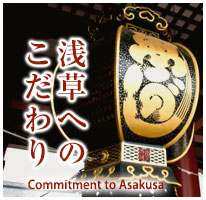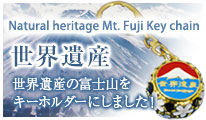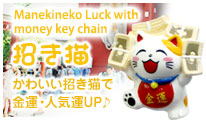HOME����
�Ԃ₵�� [Hanayashiki]
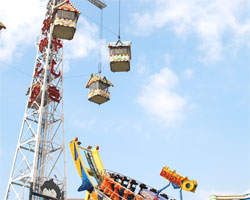
- 1853�N�i�Éi6�N�j�ɐ�ʖ̐A�؏��A�X�c�Z�O�Y�ɂ�色�O�Ƌe�H����Ƃ����A�����u�ԉ��~�v���J�������B�����̕~�n�ʐς͖�80000m2�������B�]�ˊ��͒��l�A�o�l��̏W��̏��剜�̏�����̌e���̏�Ƃ��ė��p����A�u�����R���B��̗V������B
������1953�N�i���a28�N�j�̃��[���[�R�[�X�^�[�A1950�N�i���a25�N�j��Bee�^���[�Ȃnj��݂���A�g���N�V�������o�ꂵ�n�߂��B���炭����������炸�A���p����{�݂��Ƃɉ��Ȃǂŗ������x�����`������Ă����B
2011�N�i����23�N�j3���A�����������~�Ւn��3�K���Ă̐V�����r�����I�[�v�������B�܂��A���̒��ɂ���V���������~�u���������~ �`���̉���`�v�������ɃI�[�v�������B
In 1853 (6th year of Emperor Kaei) Morita Rokusaburo, a plant merchant from Sendagi, opened a botanical garden, specialising in peonies and crysanthemums, called Hanyashiki.
At that time the land area was 80,000�u
In the Edo period masters of tea ceremony, poets, ladies maids etc used the park as a place of rest. The only attraction at that time was a slide.
In 1950 (25th year of Emperor Showa) a Bee tower was built, and in 1953 (28th year of Emperor Showa) a roller coaster, since followed by the installation of other attractions to the present day.
For a long time there was no entrance fee, customers went to a ticket booth to purchase tickets for the various attractions.
In March 2011 (23rd year of Emperor Heisei) the original haunted house attraction was demolished and a new 3 storey house was built.
At the same time a new ghost attraction, known as �eSakura no Onryou�f was added to the original ghosts included in the haunted house
�� [Senso-ji]
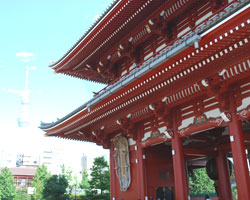
- ���i�������j�Ƃ́A�����s�䓌��ڂɂ��铌���s���ŌÂ̎��ł���B�R���͋����R�B�{���͐��ω���F�i���傤����̂�ڂ��j�B���͓V��@�ɑ����Ă���������E����Ɨ����A���ω��@�̑��{�R�ƂȂ����B�ω���F��{���Ƃ��邱�Ƃ���u�ω��v���邢�́u�̊ω��l�v�ƒʏ̂���A�L���e���܂�Ă���B�����s���ł́A�B��̍Ⓦ�O�\�O�ӏ��ω����̎D���i13�ԁj�ł���B�]�ˎO�\�O�ӏ��ω����̎D���i1�ԁj�ł�����B
Senso-ji is the oldest temple in the Tokyo metropolitan area. It is located in Taito ward, Asakusa ni-chome.
Senso-ji is also known by its Bhuddist name of Kinryu zan.
The main god worshipped at Senso-ji is Sho Kannon Bosatsu.
From its foundation Senso-ji was a member of the Ten Dai shyu sect, however after World War II it left to establish its own sect called the Sho Kannon Bosatsu.
Although Kannon Bosatsu was the official Bhuddist name for Senso-ji, it is informally known as either �eAsakusa Kannon�f or �eAsakusa no Kannon sama�f .
In the Tokyo metropolitan area Senso-ji is number 13 on the traditional pilgrim�f s route known as the Bando Sanjusan Kannon Reisho.
In the Edo period Senso-ji was number one on the Bando Sanjusan Kannon Reisho.
�y����z [Kaminarimon]
�\�Q�������̖�B�؍ȑ��̔��r��Ō������ĉE�̊Ԃɕ��_���A���̊Ԃɗ��_�������u���邱�Ƃ��琳���ɂ́u�����_��v�Ƃ������u����v�̒ʏ̂Œʂ��Ă���B�c�����N�i1865�N�j�ɏĎ���A���炭���݂̖傪���Ă��Ă��������a35�N�i1960�N�j�A��1���I�Ԃ�ɓS�R���N���[�g���ōČ����ꂽ�B���ƉƁE�����K�V�����ω��ɋF�肵�ĕa�C���������̂��߂Ɋ�i�������̂ł���B����ɂ͏����d��Y�Ɓi���p�i�\�j�b�N�j�̑������B�O�ЍՂ̎��Ƒ䕗�����̎���������܂��B
The Omotesando entrance gate.
On the right and left hand-sides, respectively, of the Kirizumazukuri style(gable roof) Hakkyaku gate stand the Shinto gods Fuujin and Raijin. The official name of the gate is the Fuuraii jin gate,
although informally it is called the �eKaminari Gate�f.
In the first year of the Keiou era (1865) the Kaminari gate burnt down and a temporary gate was constructed. It was not until 100 years later that a new concrete and iron gate was built.
The gate was donated by business man Matsushita Konosuke, who after praying at the temple consequently recovered from an illness he had been suffering from.
The huge red lantern which hangs in the centre of the Kaminari gate was donated by Matsushita Electric Co. (now known as Panasonic).
On a few occasions, such as the Sanja matsuri and when there is a typhoon, the lantern is collapsed.
�@������ [Asakusa Nakamise]
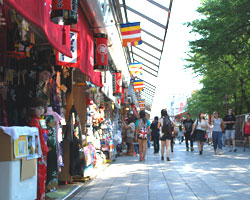
- ���傩���Ɏ���\�Q���̗����ɂ݂͂₰���A�َq�Ȃǂ鏤�X���������сA�u�������v�ƌĂ�Ă���B
���X�͓�����54�X�A������35�X�𐔂���B���@���z���̊O�ς����X�܂́A�֓���k�Ђɂ���Ќ�A�吳14�N�i1925�N�j�ɓS�R���N���[�g���ōČ����ꂽ���̂ł���B
From the Kaminari gate to the Houzou gate, along Omotesando street lined with souvenir shops and snack shops, is an area known as Nakamise.
On the east side there are 54 shops and on the west side there are 35.
The shops, which had temple-style facades, were rebuilt in iron and concrete in 1925 (year 14 of the Taishou Emperor) after being damaged in the Great Eastern earthquake.
�@�V������ [Asakusa Shin Nakamise]
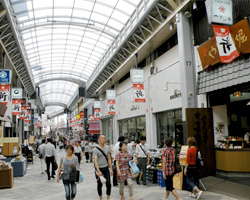
- �̏��X�X�𓌐��ɓ˂��ʂ�V���������X�X�B�ʏ��u����Ȃ��v�B�S��380M�ɋy�Ԑő�̃A�[�P�[�h��108�X�܂����ԁB
�������ɑ��āu�V�������v�Ƃ́A�]�˂̒������A���a�̐V�������Ƃ��������̂ł���B
Asakusa Shin Nakamise runs directly east to west in Asakusa arcade.
It�f s nickname is Shin naka.
Its total length is 380 metres and has a total of 108 shops along its length.
Nakamise is said to have an Edo period atmosphere, while Shin Nakamise has a Showa period feel.
�`�@�@�ʂ� [Denpo-in dori]
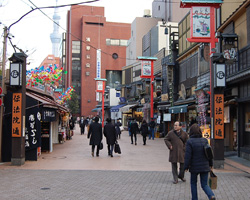
- ���������ʂ�ƐZ��ʂ�ɋ��܂ꂽ�A�`�@�@�𒆐S�ɍ��E��200���[�g������Ȃ�ʂ���w���B���܂��܂Ȗ�����X�܂�����ł���ɂ��₩�Ȓʂ�ŁA�]�ˏ�̂��钬���݂ŁA�����U����y���߂�B
Denpo-in is located halfway between Nakamise dori and Asakusa roku dori on the 200 metre Denpo-in dori.
Denpo-in dori is a lively street lined with a variety of famous shops. With an Edo period atmosphere you can enjoy strolling in this downtown area.
������ʂ� [Asakusa sushiya dori]
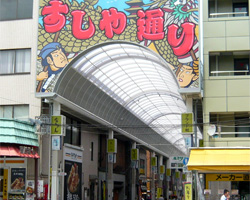
- ������ʂ菤�X�X�́A�����̗��j�ƂƂ��ɂ��̗��j���d�˂Ă����S���^�A�[�P�[�h�B
����ʂ肩������Z�拻�s�X�ɒʂ��铹��8���[�g���A����100���[�g���̏��X�X�ŁA��1���ڂɈʒu���Ă���A�`�@�@�ʂ�E���ʂ������E�Ђ����ʂ蓙�ƂƂ��Ɍ����Z�拻�s�X�ɂ͂��铹�Ƃ��ČÂ�����l�ʂ�œ�����Ă���B
Asakusa sushiya dori is a covered arcade with a long history.
Asakusa sushiya dori, in Asakusa 1-chome, runs from Kaminari mon street to Asakusa roku kougyougai street and is 8 metres wide and 100 metres long.
As a number of streets, such as Denpo-in street, Tanuki yokocho and Hisago street among others, lead into Koen roku kougyougai, from the past to the present day,
this area has been a popular and lively place.
�Z��u���[�h�E�F�C�i�f��ْʂ�j [Rokku Broadway (Movie theater street)]
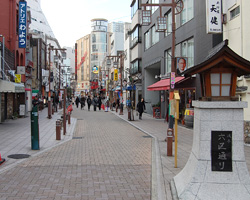
- �`�@�@�ʂ肩����G�L�X�v���X�E�w�ւƒʂ���A�S����100���[�g���̒ʂ�B
����Đ����������l��|�l�̖��Ղ��c�����X�X�ł���B
�ʂ�̗��e�̊X���ɂ́A���\����|�\�l���Љ��ʐ^�Ɖ�����ݒu����Ă���A�����̗����ɐΓ����݂����Ă���B�]�˂̊X���݂�͂���`�@�@�ʂ�ɂ�Ȃ邽�߁A���̕��͋C�Ȃ�Ȃ��悤�ɂ��鉉�o���Ă���B
����قǒ����Ȃ��ʂ肾���A���H�X����r�I�����̂������B
A street of about 100 meters which leads to the Tsukuba express Asakusa station from Denpoin street.
This is a street which was promoted and loved by the famous writers and entertainers of the past who are remembered in the area.
Pictures and explanations, introducing the artists who represent Asakusa, are displayed on streetlights on both sides of the street,
and stone monuments can be seen at either entrance of the street.
The Edo period feel of Denpo-in dori which connects to Rokku Broadway has also been maintained.
Although it is not a very long street there is a relatively large number of restaurants and eating places.
�n�����X�� [Asakusa chika shotengai]
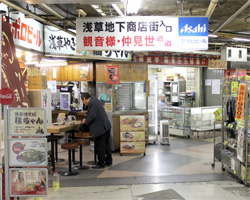
- ������w���D���i�����ւ́j���o��Ƃ����������{���߂Ă̒n�����X��B ���낢��Ȃ��X������A�}�X�R�~�ɂ��悭�Љ��Ă���B�J�̂Ƃ��Ȃǐ����ʂւʂꂸ�ɂ�����ߓ��ɂȂ�B�\�ɂ��Ɛ��l������Ƃ���ƕ]���B
If you take the Ginza line, heading for Tobu, and get off at Asakusa station then take the first left after going through the ticket gate
you will come to Japan�f s oldest underground shopping arcade.
You will find a variety of shops many of which have been featured in the mass media.
Whatever the weather you can head towards Senso-ji in comfort.
It is rumoured that you can see many beautiful women there.
�Ђ����ʂ� [Hisago dori]
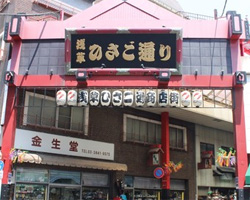
- �k�����A�Z�拻�s�X���猾��ʂ�܂ŁA�S��180M�̃A�[�P�[�h�����X�X�B
�吳13�N�̋�搮����A�������X�̎��Ȏ����ɂ�铹�H���������������ɒa�������B���̗��N�A���Ă����������̂Ђ傤����r�Ɉ��݁u�Ђ����ʂ�v�Ɩ��t����ꂽ�B
���a30�N�ɓ����s��������ꍆ�̓S�ؑS���J���A�[�P�[�h�ɂ��Ĉȍ~�A�炵���u���v���R���Z�v�g�Ƃ����u�]�ˊX�\�z�v���������悤�Ƃ��Ă���B
In the north west of Asakusa, going from Rokku kougyougai to Genma dori, you can find an arcade-style street of 180 metres in length.
After the land readjustment of 1924 (13th year of the Taishou Emperor), the shop owners of Hisago dori used their own money to renovate the arcade.
The following year the street took its name, Hisago dori (gourd street) from the similarly named Hyoutan Pond (Gourd Pond) formerly found in Asakusa Park.
In 1955 (the 30th year of Emperor Showa) Hisago dori�f s arcade was the first to be given official permission by Tokyo-to to use the tekin zenfuku kaihei shiki arcade system.
After this the arcade developed the concept of an Edo town image.
�����ϋ�����X [Kappabashi dougugai]
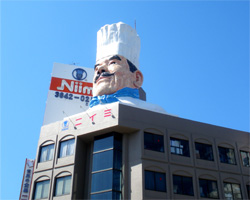
- �䓌�搼�� - �����J�n��ɂ���A�H���E��ށE�������E�H�i�T���v���E�H�ށE�����ߑ��Ȃǂ��ꊇ�Ɉ���������̖≮�X�̎��ł���B
���{��̓���X�ł���A�����ϋ��A���H������X�A�����ϋ�����X�Ƃ��Ă��B �͓����}�X�R�b�g�ɂ��Ă��邪�A�u�͓����v�ł͂Ȃ��B
Located in Matsugaya in Taito-ku Nishi Asakusa, Kappabashi dougugai is known for its kitchen speciality wholesale shops selling everything from tableware,
packaging supplies, kitchen utensils, faux food samples, food materials, staff uniforms etc.
Japan�f s number one district for tools, it is known as Kappabashi, Aibabashi dougugai and Kappabashi dougugai.
Although the kappa (mythical water-dwelling creature) is the mascot of the street this is not the original meaning of the street�fs name.
��� [Asakusa Public Hall]
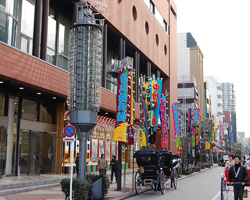
- 1977�N�ɂ����痎�Ƃ��B���N1���ɐV�t�̕��ꂪ�J�Â����ق��A�|�\��܁A���ˑ��i�N�Y�ꖟ�ˋ������J�^��j�Ȃǂ��J�Â����ق��A�f��̏�f��A���x�Ȃǂ���ɊJ�Â���Ă���B
���Ȑ���1082�ȁB�������A�N���N�n��1���̑唼�͐V�t�̕��ꂪ�J�Â���邽�߁A��ʂł̗��p�͂ł��Ȃ��B
The theatre was founded in 1977.
Every year in January a new kabuki performance is shown. The Asakusa geinou taishou, manzai taikai, (televised year end comedy contest) and other events are also held.
In addition, films and traditional dance performances are also shown here.
The theatre seats 1082.
However, during the New Year period and the showing of the new kabuki performance the theatre is not open to the public.
�������߂̖��X [Recommendations]







